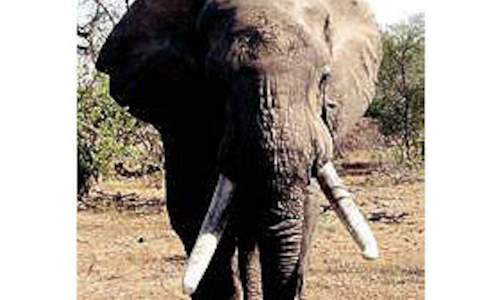The bush was littered with people, watching his every move. They saw him desperately wanting to outrun the helicopter, saw the dart strike. He ran back and forth as lead-filled his feet and eventually he sagged to the ground, oblivious of the hands that soon afterward probed everywhere.

They stuck a twig softly down his trunk to make sure he could breathe easily. They measured his teeth, his feet, his heartbeat, drew blood. Cameras rolled and clicked almost non-stop.
Men and women, dressed in familiar Kruger National Park (KNP) greens, tugged, pushed, drilled and clamped to fit a new leather collar around the 55-year old neck. A cautious eye on the clock marked their progress. Finally, they were done.
A few last minute photographs before the rangers gathered everyone into the vehicles. SANParks veterinarian, dr Peter Buss stuck the last needle.
The reversal drug kicked in and the giant rocked himself upright. He paused briefly before he trudged away from the throng.
It was then that Crocodile Bridge section ranger Neels van Wyk found a few moments in his wife's embrace for an emotional celebration of both his father, who had passed away three years ago to the day, and Duke, a living legend of the Kruger National Park.
Silently, Neels and Cindy saluted the giant as he disappeared from view. Duke is one of the emerging tuskers in the park, following in the footsteps of the magnificent seven, Mafunyane, Joao, Shingwedzi, Dzombo, Ndlulamiti, Shawu and Kambaku.

Probably the best-known living tusker, Duke usually roams the Crocodile Bridge section of the park, occasionally venturing into the adjacent Lower Sabie and Tshokwane sections.
Although both his tusks broke off last year, they were not lost, largely due to the efforts of the teams of Neels and fellow section ranger, Steven Whitfield, who is based in Tshokwane.
It was on Neels' suggestion that John Turner, chairman of the Honorary Ranger's (HR) counter poaching and ranger support services unit, raised the necessary funds for the collar itself and the collaring operation.
The collaring coincided with the annual HR fundraising event known as Mokhololo and allowed John and several other HRs, as well as their guests to attend the fruition of their fundraising drive.
The entire collaring operation after Duke went down took about 30 minutes, which made Dr Markus Hofmeyr, head of SANParks veterinary services a happy man. Markus said he was initially worried about how Duke would handle the tranquilliser and anaesthesia, but the outcome was as good as could be wished for.
According to Markus, Duke is in excellent condition and may live for years to come. The collar, however, will help rangers greatly to retrieve the carcass when Duke dies. His skull and tusks will then become part of the display at the elephant hall in Letaba rest camp, where he will take his place alongisde the magnificent seven.

 Ever since the Magnificent Seven was first named in the 1970s, Kruger's elephants with large tusks have been a source of awe and inspiration...
Ever since the Magnificent Seven was first named in the 1970s, Kruger's elephants with large tusks have been a source of awe and inspiration...